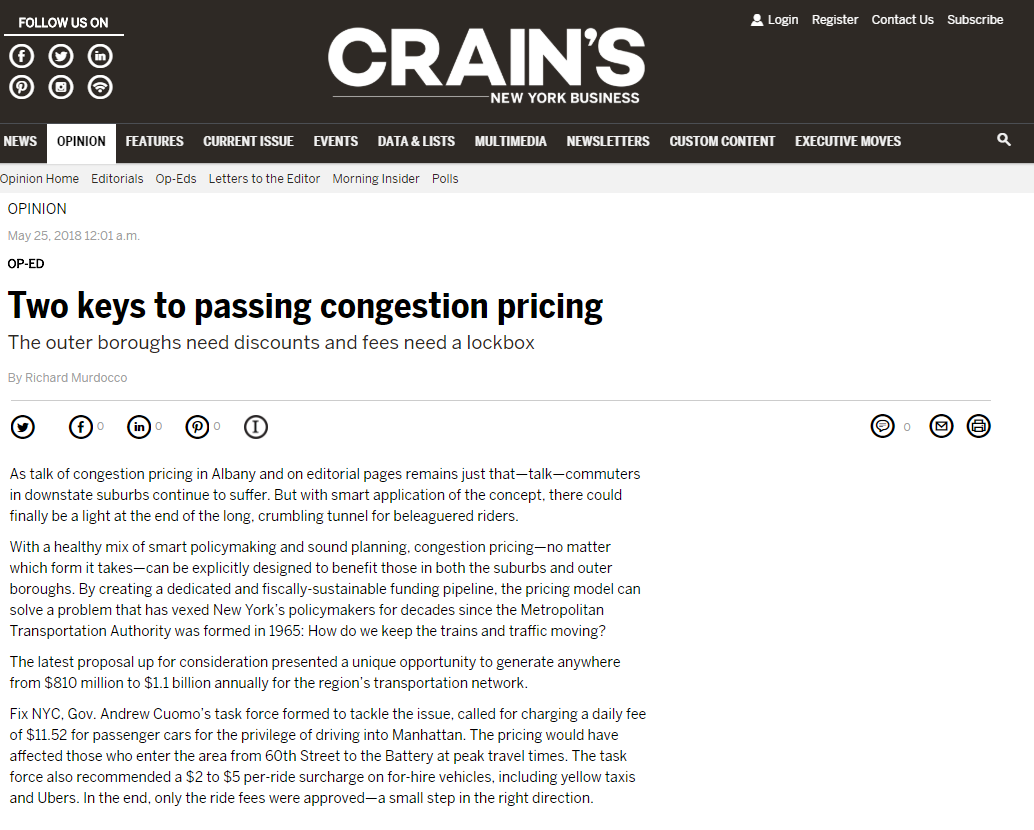The following op-ed was written for Crain’s New York, and published on May 25th, 2018. You can read the original here. Interested in supporting The Foggiest Idea’s award-winning reporting and analysis? Click here.
The outer boroughs need discounts and fees need a lockbox
As talk of congestion pricing in Albany and on editorial pages remains just that—talk—commuters in downstate suburbs continue to suffer. But with smart application of the concept, there could finally be a light at the end of the long, crumbling tunnel for beleaguered riders.
With a healthy mix of smart policymaking and sound planning, congestion pricing—no matter which form it takes—can be explicitly designed to benefit those in both the suburbs and outer boroughs. By creating a dedicated and fiscally-sustainable funding pipeline, the pricing model can solve a problem that has vexed New York’s policymakers for decades since the Metropolitan Transportation Authority was formed in 1965: How do we keep the trains and traffic moving?
The latest proposal up for consideration presented a unique opportunity to generate anywhere from $810 million to $1.1 billion annually for the region’s transportation network.
Fix NYC, Gov. Andrew Cuomo’s task force formed to tackle the issue, called for charging a daily fee of $11.52 for passenger cars for the privilege of driving into Manhattan. The pricing would have affected those who enter the area from 60th Street to the Battery at peak travel times. The task force also recommended a $2 to $5 per-ride surcharge on for-hire vehicles, including yellow taxis and Ubers. In the end, only the ride fees were approved—a small step in the right direction.
Fix NYC’s blueprint was far from perfect for those who reside outside of Manhattan. It sadly did not include reduced tolls for outer-borough bridges such as the Verrazano, Throgs Neck and Whitestone, which had previously been proposed to offset the new cost burdens. That provision should be included once again. As former Assemblyman Richard Brodsky recently wrote in Crain’s of the Fix NYC plan, “It hit the outer boroughs hard. Regional disparities are hard to defend politically.” He’s right—especially when tolls are rising while levels of service on the region’s roads continue to decline.
That said, the pricing concept doesn’t deserve to die, but it should be tweaked so a newly minted funding stream goes directly towards maintaining and enhancing the transit and transportation networks that serve those affected by the new fees.
In recent years, the need for dedicated improvement funding in the city’s environs has become more pronounced as suburban commutes became nothing short of brutal. In January 2018, the Long Island Rail Road was only running on schedule 83.9% of the time—the worst performance the system has experienced in 22 years, and down from 91.6% in January 2017.
The picture is no less bleak for those on the subways. In October 2017 the Independent Budget Office found that the average number of subway delays in a month had increased from about 20,000 in 2012 to more than 67,450 in May of that year. As the city population continues to swell, the delays are expected to only get worse.
All of this degradation in service is occurring while the MTA is grappling with escalating capital project costs.
With the right financial controls, a smart pricing plan offers a less-intrusive way to begin addressing these woes, and riders and drivers in Staten Island, Queens, Brooklyn, Westchester and Long Island can see the benefits.
At a time when metropolitan regions fiercely compete for workers, companies, and international prestige, we cannot lose sight in the economic and practical value that ambitious capital endeavors like the Second Avenue subway or the LIRR’s East Side Access create. Once completed, these projects will ensure that the city and its suburbs remain competitive. Expensive yes, but not impossible no—especially with new and innovative sources of funding.
The principal drivers of project cost must continue to be assessed by the MTA’s leadership and policymakers, but fear of rising project prices cannot keep us from looking for ways to improve accessibility. We need these enhancements, and kicking the can down the road only makes things more difficult as the system degrades further.
Our region’s antiquated infrastructure is struggling to meet the demands of riders in the 21st century. An annual, regular investment source can help policymakers on both sides of the East River plan accordingly.
If congestion pricing isn’t eventually implemented in some form, riders and drivers won’t be the only ones who are perennially gridlocked. Our region’s economic progress will be stuck right alongside them.
Richard Murdocco, whose work is published at TheFoggiestIdea.org, is an adjunct professor in Stony Brook University’s public policy graduate program.











